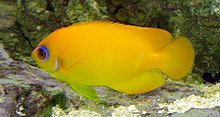| Lemonpeel angelfish | |
|---|---|

| |
| Conservation status | |
 Least Concern (IUCN 3.1) | |
| Scientific classification | |
| Domain: | Eukaryota |
| Kingdom: | Animalia |
| Phylum: | Chordata |
| Class: | Actinopterygii |
| Order: | Acanthuriformes |
| Family: | Pomacanthidae |
| Genus: | Centropyge |
| Species: | C. flavissima |
| Binomial name | |
| Centropyge flavissima (Cuvier, 1831) | |
| Synonyms | |
|
Holacanthus flavissimus Cuvier, 1831 | |
The lemonpeel angelfish (Centropyge flavissima), also known as the yellow angelfish, is a species of marine ray-finned fish, a marine angelfish belonging to the family Pomacanthidae. It is found in the Indo-Pacific region.
Description
The lemonpeel angelfish is bright yellow in colour with a bluish or whitish ring surrounding the eye. There is a black blotch on the rear margin of the gill cover. The spine on the preoperculum is blue and the dorsal, anal and caudal fins have blue margins. The juveniles have an ocellus on the flank which is black with blue edges. The dorsal fin contains 14 spines and 15-16 soft rays while the anal fin has 3 spines and 16 soft rays. This species attains a maximum total length of 14 centimetres (5.5 in).
Distribution

The lemonpeel angelfish is found in the Indo-Pacific, the core of its distribution is in the Central Pacific from the Ryukyu Islands and Ogasawara Islands of Southern Japan in the north, east to the Tuamotu Islands and south to Australia. It occurs around some Indian Ocean islands too. In Australia it occurs from the northern Great Barrier Reef south to Moreton Bay in Queensland and the Solitary Islands in New South Wales. In addition, it is found off Lord Howe Island in the Tasman Sea and the Australian Indian Ocean territories of Christmas Island and Cocos (Keeling) Islands. Records from some parts of the western Pacific Ocean are likely to refer to vagrants. It is absent from Hawaii and Johnston Atoll.
Habitat and biology

The lemonpeel angelfish is found in shallow water, typically shallower than 20 metres (66 ft), in areas richness coral growth in lagoons and seaward reefs. The juveniles are more secretive then the adults. They are normally encountered in small groups, a harem of a single male and several females. This species is a protogynous hermaphrodite and if there is no male in the group the dominant female may change to a male, and this change can be reversed. It feeds mainly on filamentous algae.
Systematics
The lemonpeel angelfish was first formally described as Holocanthus flavissimus in 1831 by the French anatomist Georges Cuvier (1769-1832) with the type locality given as Uléa in the Caroline Islands. The specific name flavissima means “very yellow” referring to its colour. Within the genus Centropyge this species is considered, by some authorities, to be in the subgenus Centropyge.
Utilisation
The lemonpeel angelfish is common in the aquarium trade.
References
- ^ Pyle, R.; Myers, R.F.; Rocha, L.A. (2010). "Centropyge flavissima". IUCN Red List of Threatened Species. 2010: e.T165878A6155199. doi:10.2305/IUCN.UK.2010-4.RLTS.T165878A6155199.en. Retrieved 20 November 2021.
- ^ Froese, Rainer; Pauly, Daniel (eds.). "Centropyge flavissima". FishBase. December 2019 version.
- ^ Bray, D.J. (2020). "Centropyge flavissima". Fishes of Australia. Museums Victoria. Retrieved 24 January 2021.
- Eschmeyer, William N.; Fricke, Ron & van der Laan, Richard (eds.). "Species in the genus Centropyge". Catalog of Fishes. California Academy of Sciences. Retrieved 24 January 2021.
- Christopher Scharpf & Kenneth J. Lazara (21 July 2020). "Order ACANTHURIFORMES (part 1): Families LOBOTIDAE, POMACANTHIDAE, DREPANEIDAE and CHAETODONTIDAE". The ETYFish Project Fish Name Etymology Database. Christopher Scharpf and Kenneth J. Lazara. Retrieved 24 January 2021.
- "Centropyge flavissima". Integrated Taxonomic Information System. Retrieved 6 June 2006.
External links
- Centropyge.net info page
- Reefpedia.com info page
- Photos of Lemonpeel angelfish on Sealife Collection
| Taxon identifiers | |
|---|---|
| Centropyge flavissima |
|
| Holacanthus flavissimus | |